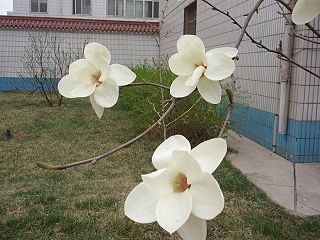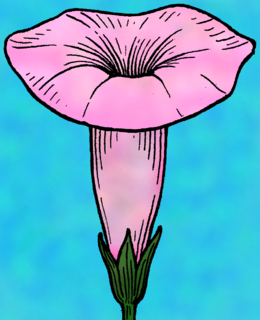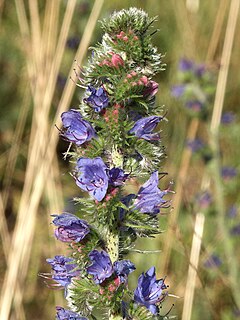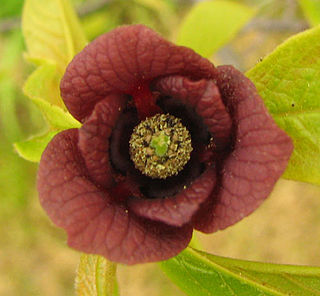
The Apiales are an order of flowering plants. The families are those recognized in the APG III system. This is typical of the newer classifications, though there is some slight variation and in particular, the Torriceliaceae may be divided.

The Dipsacales are an order of flowering plants, included within the asterid group of dicotyledons. In the APG III system of 2009, the order includes only two families, Adoxaceae and a broadly defined Caprifoliaceae. Some well-known members of the Dipsacales order are honeysuckle, elder, viburnum, and valerian.

The Lamiales are an order in the asterid group of dicotyledonous flowering plants. It includes about 23,810 species, 1,059 genera, and is divided into about 24 families. Well-known or economically important members of this order include lavender, lilac, olive, jasmine, the ash tree, teak, snapdragon, sesame, psyllium, garden sage, and a number of table herbs such as mint, basil, and rosemary.

The Malvales are an order of flowering plants. As circumscribed by APG II-system, the order includes about 6000 species within 9 families. The order is placed in the eurosids II, which are part of the eudicots.

The Cornales are an order of flowering plants, early diverging among the asterids, containing about 600 species. Plants within the Cornales usually have four-parted flowers, drupaceous fruits, and inferior to half-inferior gynoecia topped with disc-shaped nectaries.

The dicotyledons, also known as dicots, are one of the two groups into which all the flowering plants or angiosperms were formerly divided. The name refers to one of the typical characteristics of the group, namely that the seed has two embryonic leaves or cotyledons. There are around 200,000 species within this group. The other group of flowering plants were called monocotyledons or monocots, typically having one cotyledon. Historically, these two groups formed the two divisions of the flowering plants.
Under the International Code of Nomenclature for algae, fungi, and plants (ICN), Rosidae is a botanical name at the rank of subclass. Circumscription of the subclass will vary with the taxonomic system being used; the only requirement being that it includes the family Rosaceae.

Magnoliopsida is a valid botanical name for a class of flowering plants. By definition the class will include the family Magnoliaceae, but its circumscription can otherwise vary, being more inclusive or less inclusive depending upon the classification system being discussed.

Ranunculales is an order of flowering plants. Of necessity it contains the family Ranunculaceae, the buttercup family, because the name of the order is based on the name of a genus in that family. Ranunculales belongs to a paraphyletic group known as the basal eudicots. It is the most basal clade in this group; in other words, it is sister to the remaining eudicots. Widely known members include poppies, barberries, and buttercups.

Proteales is the botanical name of an order of flowering plants consisting of three families. The Proteales have been recognized by almost all taxonomists.

The Angiosperm Phylogeny Group, or APG, is an informal international group of systematic botanists who collaborate to establish a consensus on the taxonomy of flowering plants (angiosperms) that reflects new knowledge about plant relationships discovered through phylogenetic studies.

In the APG IV system (2016) for the classification of flowering plants, the name asterids denotes a clade. Common examples include the common daisy, the forget-me-nots, nightshades, the common sunflower, petunias, yacon, morning glory, sweet potato, coffee, lavender, lilac, olive, jasmine, honeysuckle, ash tree, teak, snapdragon, sesame, psyllium, garden sage, table herbs such as mint, basil, and rosemary, and rainforest trees such as Brazil nut.
Dillenidae is a botanical name at the rank of subclass. Circumscription of the subclass will vary with the taxonomic system being used; the only requirement being that it includes the family Dilleniaceae. A well-known system that uses this name is the Cronquist system, and in the original 1981 version of the system the circumscription was:

(Sympetaly directs here)
The APG II system of plant classification is the second, now obsolete, version of a modern, mostly molecular-based, system of plant taxonomy that was published in April 2003 by the Angiosperm Phylogeny Group. It was a revision of the first APG system, published in 1998, and was superseded in 2009 by a further revision, the APG III system.

Boraginales is a valid taxonomic name at the rank of order for a group of flowering plants. It includes Boraginaceae and closely related asterid families. The Boraginales include about 125 genera, 2,700 species and its herbs, shrubs, trees and lianas (vines) have a worldwide distribution.

Magnoliids are a group of flowering plants. Until recently, the group included about 9,000 species, including magnolias, nutmeg, bay laurel, cinnamon, avocado, black pepper, tulip tree and many others. That group is characterized by trimerous flowers, pollen with one pore, and usually branching-veined leaves.

Caryophyllales is a diverse and heterogeneous order of flowering plants that includes the cacti, carnations, amaranths, ice plants, beets, and many carnivorous plants. Many members are succulent, having fleshy stems or leaves. The betalain pigments are unique in plants of this order and occur in all its families with the exception of Caryophyllaceae and Molluginaceae.

Bruniales is a valid botanic name at the rank of order. Until recently it was not in use, but a 2008 study suggested that Bruniaceae and Columelliaceae are sister clades. The latest revision of the APG system, APG III, places both families as the only members of the order Bruniales, which is sister to the Apiales, and one of the asterid taxa.

The superasterids are members of a large clade of flowering plants, containing more than 122,000 species.